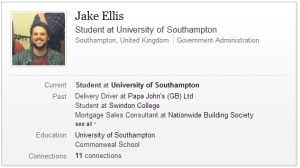My experiences of this Living and Working on the Web module have been interesting. Before commencing it I would have said that I had a decent grasp of many technological methods that are gradually expanding into our every day lives. I was capable of writing in HTML to a decent standard, could program in BASIC, had a relatively fast word-per-minute typing speed and had used various different programs such as Microsoft Word, Excel, Access as well as Macromedia Flash and Dreamweaver to a passable standard.
However, the use of social media was something that I had never anticipated would be a fundamental factor in any attempts to get a job in the future. Previously, my use had solely been consigned to using Facebook on a personal level as well as various other sites such as Imgur and several football forums. As you might guess, this has not had a great bearing upon my online profile in a professional measure.
Living and Working on the Web has allowed me to increase my online profile and forge links with others in the field of technology and communications. However, on reflection I should have made more of an effort to connect with people in the field of work that I wish to go into. However, this was made more difficult by the lack of people in the criminal justice system who are communicable via social media. This may be because of restrictions on the information that can be broadcast through the media and has significantly restricted my efforts to connect with people via the medium of Twitter (my profile on this can be found by clicking on the image below). Despite this, I have managed to increase my standing online through Twitter, just not in the manner I had hoped, with my number of followers increasing to 76; several of which hold some standing in the world of technology and social media. On top of this I have also increased the number of people I follow which can increase my standing further through retweets and hashtags. This is a massive increase on my previous use of Twitter, which had been dismally poor despite having an open account for several years.
On top of this, I have also created a profile on LinkedIn, which can be found by clicking on on the image below. I have found this more useful than Twitter for interacting with those in my preferred field of work due to the ease at which I can read information that is shared and has relevance to criminal justice policy. According to LinkedIn my profile is now at ‘Expert’ level and, while I have a relatively small number of ‘connections’ at 11, it is an improvement on the online professional profile that I had before the start of this module. Even more encouragingly, in the last 30 days my profile views has increased by 29%.


